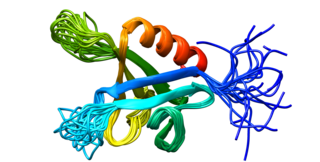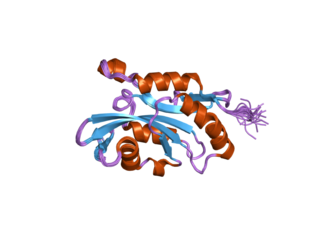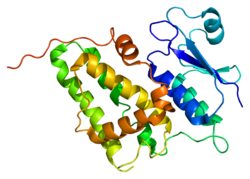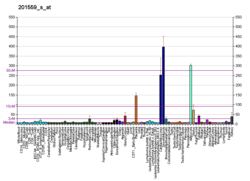
Dynamin-2 is a protein that in humans is encoded by the DNM2 gene.

Wiskott–Aldrich syndrome protein family member 2 is a protein that in humans is encoded by the WASF2 gene.

Alpha-actinin-1 is a protein that in humans is encoded by the ACTN1 gene.

Clathrin heavy chain 1 is a protein that in humans is encoded by the CLTC gene.

Dynamin-1 is a protein that in humans is encoded by the DNM1 gene.

Chloride intracellular channel protein 1 is a protein that in humans is encoded by the CLIC1 gene.

A-kinase anchor protein 9 is a protein that in humans is encoded by the AKAP9 gene. AKAP9 is also known as Centrosome- and Golgi-localized protein kinase N-associated protein (CG-NAP) or AKAP350 or AKAP450

Beta-adducin is a protein that in humans is encoded by the ADD2 gene.

H+/Cl− exchange transporter 3 is a protein that in humans is encoded by the CLCN3 gene.

Ena/VASP-like protein is a member of the Ena/VASP family of proteins that in humans is encoded by the EVL gene.

Sorting nexin-9 is a protein that in humans is encoded by the SNX9 gene.

Dynamin-3 is a protein that in humans is encoded by the DNM3 gene. The protein encoded by this gene is a member of the dynamin family which possess mechanochemical properties involved in actin-membrane processes, predominantly in membrane budding. DNM3 is upregulated in Sézary's syndrome.

Chloride intracellular channel protein 2 is a protein that in humans is encoded by the CLIC2 gene.

Potassium-chloride transporter, member 4 is a chloride potassium symporter protein. It is encoded by the gene SLC12A4.

Chloride intracellular channel protein 5 is a protein that in humans is encoded by the CLIC5 gene.

Rh family, B glycoprotein, also known as RHBG, is an ammonia transporter protein which in humans is encoded by the RHBG gene.

Chloride intracellular channel protein 3 is a protein that in humans is encoded by the CLIC3 gene. This protein is a chloride channel.

Ankyrin-3 (ANK-3), also known as ankyrin-G, is a protein from ankyrin family that in humans is encoded by the ANK3 gene.

Chloride channel CLIC-like 1 also known as CLCC1 is a human gene.

Cofilin 2 (muscle) also known as CFL2 is a protein which in humans is encoded by the CFL2 gene.


























